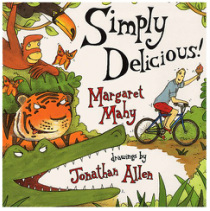If you're in the mood for picture books, Dawn Dvorak has reviewed five of them!

Simply Delicious - Margaret Mahy
"A father buys an ice cream cone for his son and bikes through the jungle to bring it home to him. This book is cute, but text heavy. There is a lot of repetition: the long description of the ice cream is said multiple times on each page, the way each animal spots the ice cream and follows along, and the way the father moves the cone around to avoid the animals. The ending is a little off, as the father hands the ice cream to his son, and all of the hungry animals eye each other for food. Also, the last scene is on the end papers, which is odd (maybe just my edition?)."

Should I Share My Ice Cream - Mo Willems
"Part of the wonderful Elephant & Piggy series. Gerald gets an ice cream cone and is trying to decide whether he should share with his best friend Piggie. He tries talking himself out of it, but eventually decides to do the right thing. Unfortunately, while he has been contemplating what to do, his ice cream has melted! Luckily, Piggie comes along with her own ice cream cone, and graciously offers a bite to Gerald. Cute book, but a bit too long for a storytime with younger children. It's a great easy reader though, and with two characters (though Gerald has much more dialogue than Piggie in this particular book), children can alternate with a parent."

Curious George and the Ice Cream Surprise - Margret & H.A. Rey's
"I read this in a storytime about ice cream, though I skipped over some of the text to get through it more quickly. Curious George is always fun though, and since we do so many songs about monkeys, it was fun to have a monkey in a book as well. In this book, Curious George is trying to beat the heat, but the pool closes, the sprinklers are turned off, the freezer breaks, and he is having a hard time flagging down the ice cream truck. When the truck passes him by for the second time, George takes off after it, eventually climbing onto the roof. When the ice cream man goes to the bank for more change, Curious George "helps" by continuing to hand out ice cream, but without collecting money. The ice cream man is upset, but the mayor generously offers to pay for everyone's ice cream, as the town could use an ice cream party. In the end, George gets his chocolate covered bananasicle."

It Looked Like Spilt Milk - Charles C. Shaw
"A simple book, but definitely a hit at storytime. Each page features a rough, white object on a navy background, along with the phrase "It looked like X, but it wasn't X." Very interactive as you can let the kids guess what each of the objects are as you read along. A couple of the pictures are a little bit harder to figure out, but you can easily skip over them. The ending is that they are all shaped clouds in the sky, which can make a great introduction for books about weather, or about any of the objects that are included."

The Ice Cream King - Steve Metzger
"I used this for an ice cream storytime, and it seemed to go over well!
A young boy goes into an ice cream shop with his mother, and she allows him to order anything he wants. An employee puts a paper crown on the boy's head, and the boy declares himself the ice cream king. As we enter this fantasy world of ice cream volcanoes, castles, moons, and oceans, the colors become vivid and bright, as the boy relates in rhyme all he will go in his ice cream kingdom. However, the boy soon realizes that he is all alone in his kingdom and he needs someone to share with (as fittingly, the sun sets on his ice cream kingdom). The boy removes his crown and the colors return to simpler black and white with red accents. The boy places his order, which includes two spoons so he can share with his mother. The last page shows a happy mother and son, with the big bowl of ice cream featuring the bright colors that existed in the ice cream kingdom! A bit text heavy in the ice cream shop, but the kingdom text is short and snappy."
